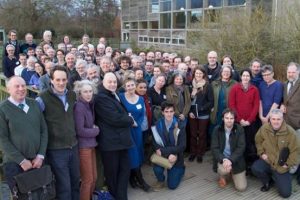On Monday 22nd May, Mike Smart from the ‘Call of the Curlew, Slimbridge Symposium’ group visited the project. Mandi and Tony had been privileged to go with Mike and Natalie Meyer from the NABU project looking around wader nesting sites in Gloucester and Worcester, before they all participated in the Slimbridge symposium the following day.

Dear Amanda and Tony
Thank you very much for showing me round your project area on Monday, and for your generous hospitality: I can’t imagine that ploughmen round the Bridges Inn get any work done of an afternoon, if they all have such large lunches.
I had already heard so much about your project, not just about the Curlew themselves, but your collaboration with farmers and the local community, that I was really keen to see it for myself. Even so, the visit was a real eye opener, as the conditions in which your Curlew are nesting are so completely different from the ones we are watching in the Severn and Avon Vales. It was a big surprise to me to see that the grass in which your birds are nesting is so short compared with ours; the grass was only belly high to a Curlew, whereas with us any Curlew that lands just disappears into the long grass.
We found a new nest during my visit, looking from the car into a roadside field; the grass was barely ankle deep in the field, which is unthinkable in our area; so that tuition in how to find nests wouldn’t be of much use to observers from our area. I was really impressed too by your 20m x 20 m electrified fences round Curlew nests; once again, the sitting birds could be seen from a distance which would not be possible in our area; but they seemed to be doing the job for birds nesting in your conditions.
 The habitat in your area is again different from ours: your birds are in fertile upland valleys between bare areas of high ground (not on the grouse moor tops themselves); ours are in riverside meadows with lush vegetation. Even so, from our conversations it looked as though some of our ideas on monitoring vegetation at the same time, would be relevant to your area; there generally seemed to be more Curlew in your area nesting in fields with a rich vegetation dominated by buttercups (not true of course in the last ones we looked at in peat base areas). It would be nice to look more closely at matching vegetation and nesting Curlew.
The habitat in your area is again different from ours: your birds are in fertile upland valleys between bare areas of high ground (not on the grouse moor tops themselves); ours are in riverside meadows with lush vegetation. Even so, from our conversations it looked as though some of our ideas on monitoring vegetation at the same time, would be relevant to your area; there generally seemed to be more Curlew in your area nesting in fields with a rich vegetation dominated by buttercups (not true of course in the last ones we looked at in peat base areas). It would be nice to look more closely at matching vegetation and nesting Curlew.
Seems to me that the habitat in your area matches more closely that found in mid-Worcestershire, where a few survive in upland parkland areas. Maybe your project can encourage those in neighbouring counties, where numbers have dwindled greatly, to conserve the remaining few pairs in their area. It really emphasizes the contraction of range that has occurred.
It was really helpful to me to compare notes with such experienced observers as yourselves on Curlew behaviour. We keep saying that a lot is unclear about basic Curlew behaviour; so it was good to look at issues like: do both sexes incubate? how do you separate males from females in the field? do both sexes bubble? Very helpful to have your view that both sexes do indeed incubate; that there is a difference between the sexes, not only in bill length and shape, but also in colouration of the upper breast (more orange in the male); and that both sexes do bubble, though the male probably does so more often. It would be really good to gather together the observations on these matters from all of the lowland sites where Curlew are being studied.
So, many thanks, once again, lots to think about and study more closely in the coming weeks. It’s really interesting to see how great are the varieties and differences between the different groups of lowland Curlew.
Mike

